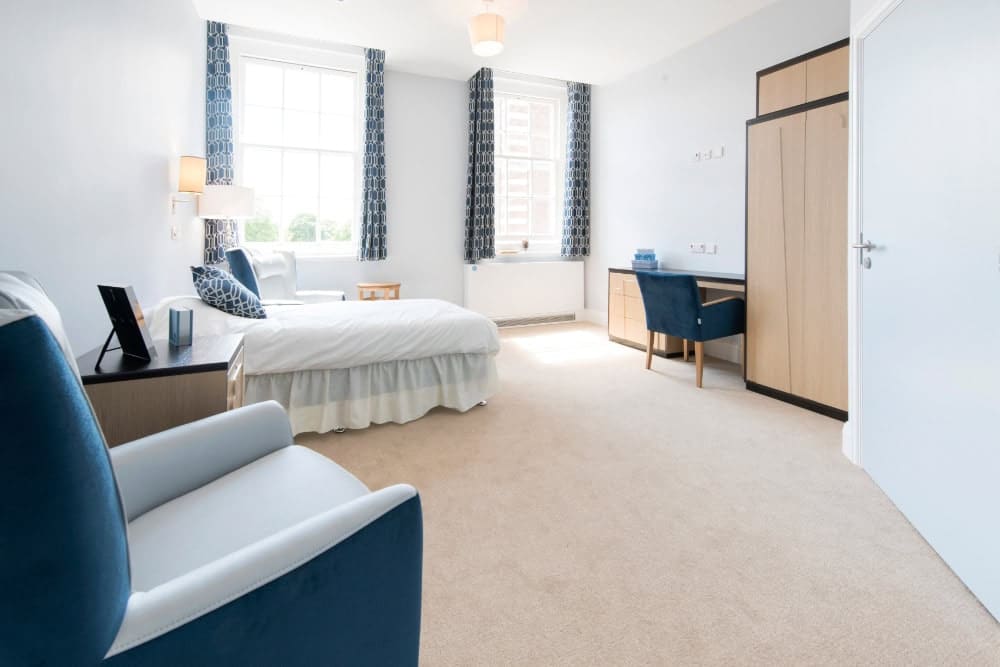Care home interior furnishings can make a meaningful difference to the mood and wellbeing of the residents in a care home. From visually stimulating to calming and soothing, choosing a scheme that will enhance the living environment is a clear step that homes can take towards improving the experience of both residents and staff, while aligning with a brand.
In a care home, one of the primary aims is to create an interior that will feel like home. That means finding curtains and blinds that fit with the home’s brand and style, while feeling suitably cosy. However, there are other considerations too, including resident needs, function, aesthetic, washability and budget.
Care home interior furnishings for reduced vision
When planning the interior furnishings in a care home for older people, consider that some of the residents’ visual acuity may be reduced. This means that something as seemingly simple as opening the curtains in the morning could be harder than anticipated, particularly if the curtain fabric is a single block colour as this makes it particularly difficult for a resident to determine where the curtains meet.
Our preferred solution to this challenge is to add a leading edge to curtains using a contrasting colour fabric. This helps to bring the edges of the curtain that meet into easy focus. This contrast technique can also be used for other items such as bedspreads to show where the edge of the bedding is and where to pull the covers back.
Another consideration for people with reduced vision is to make use of the natural light during the day. Ensure the curtains can be pulled fully to each side of the recess, making the most of the light at every window.
Interior furnishing considerations for people living with dementia
In residences where people with dementia are being cared for, there are some additional interior design features to think about. There is a tendency in dementia friendly design to aim for a relatively simple style to avoid over-stimulation. However, this can result in environments that miss the opportunity to provide a positive impact, and even joy .
For example, a scheme of pale colours or lots of dark colours can be both difficult to distinguish between, and visually boring. Considered use of colour and pattern can brighten up an environment and help to lift mood, without being garish, as well as contrasting colours making individual items more perceptible.
However, beware swirls and patterns that suggest movement, as they can cause nausea for some residents taking particular medications, such as antipsychotics . Flecked patterns can also cause distress and are usually best avoided.
What curtains are best for a care home?
Eyelet curtains on a pole are perfect for bedrooms in care homes. They are highly durable and can withstand heavy usage. These curtains use a hard-wearing, metal eyelet that is punched and fully secured into the heading. Pencil pleat and pinch pleat curtains use curtain hooks, and under heavy usage, they can sometimes fall out. Heavy-handed opening and closing is no issue for eyelet curtains.
What about curtain weight?
It is also worth considering the weight of the curtains. Long, heavy curtains may fit nicely in the care home interior scheme, particularly in high-end establishments, but practically, they can sometimes be bulky and hard to manage. If you are wanting to achieve a style where heavy curtains are a perfect match, get advice from a curtain specialist who can recommend fabrics and linings that will give you your desired look, without impacting usability.
Curtain length is also important
When specifying curtains for care homes, we recommend that any floor length curtains actually finish a little above the floor – usually 20-30mm. This makes it easier to clean around the curtains and ensures that any liquid that reaches the floor isn’t wicked up.
When measuring for curtains, keep in mind any fixed furniture, radiators or emergency signage that may be present. If in doubt, ask for a survey from your curtain supplier. Most will offer a free site survey and be able to give advice on how to dress windows in difficult locations to optimise the light and complement the décor.
What is the best blind to install in a care home?
Whilst Roman blinds look beautiful, they don’t withstand regular vigorous or enthusiastic use. In a busy care home environment, durability is so important. We generally recommend a laminated roller blind which combines the strength and functionality of a standard roller blind, but can use any fire retardant fabric you choose, making it easy to match or coordinate with colour schemes, furniture or other soft furnishings.
Fire retardant curtains for care homes
As with any public building, care homes should always ensure that all curtains, blinds and soft furnishings are made from fire retardant fabrics. We always recommend an inherently fire retardant fabric, as they retain their fire retardant properties when washed, which may not always be the case for fabrics that are treated with a fire retardant coating. Look out for curtains with an ‘FR label’ – a label stating that the fabric is fire retardant. This will prove compliance with current legislation.
If you’re looking for curtains, blinds or soft furnishings for a care home, get in touch with our experts who can help you to design a therapeutic care home environment that brings joy and comfort to residents, while also being both practical and compliant with fire retardancy regulations.
Thanks to the team at Panaz for their thoughts on fabric design for Dementia.
















![ESPO Framework Supplier Logo - Main [JPEG]](https://bridgecontractinteriors.com/wp-content/uploads/2024/10/ESPO-Framework-Supplier-Logo-Main-JPEG.jpg)